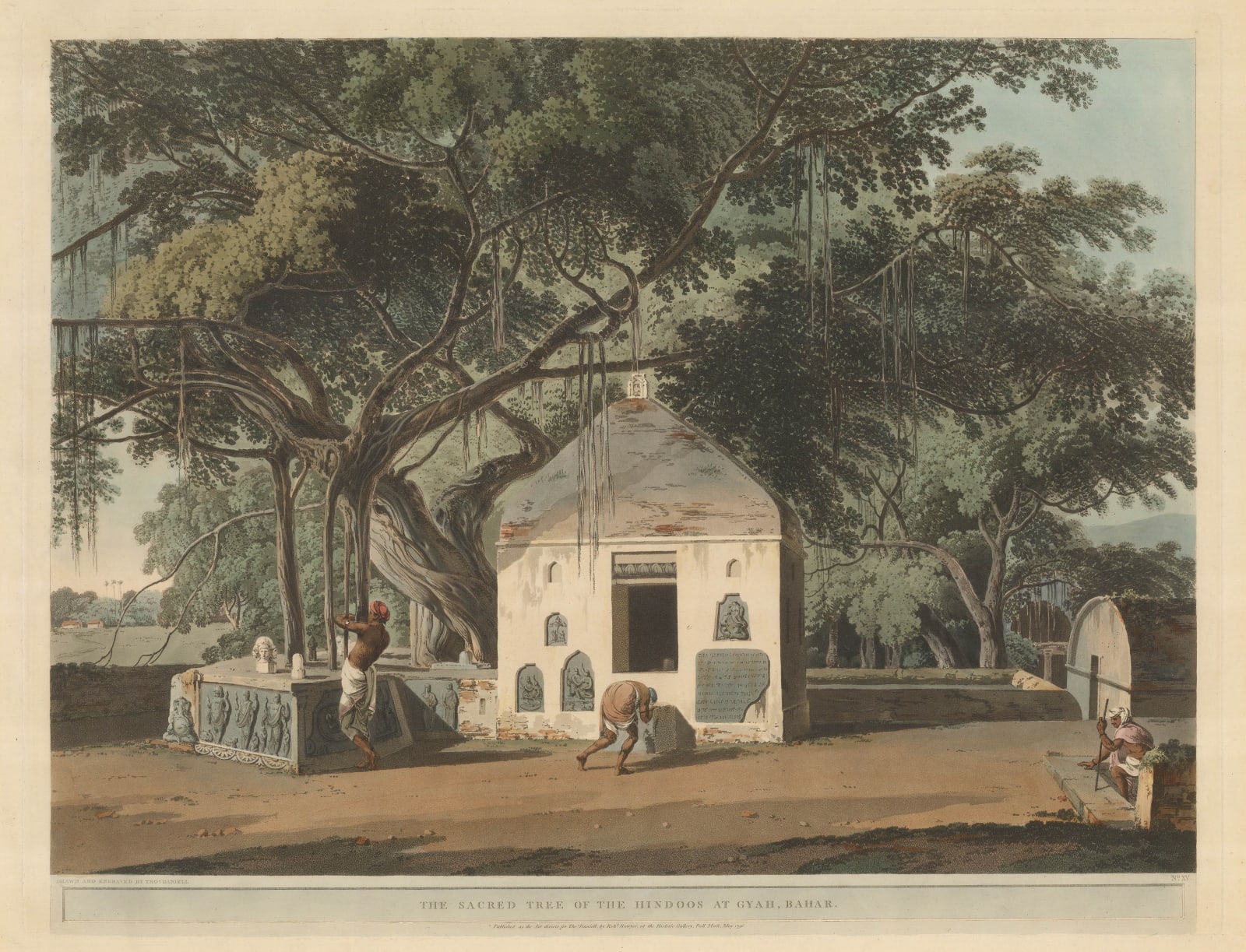Thomas & William Daniell
India - Bihar, The Akshaya Vat, 1796
An original antique hand-coloured aquatint
19 ½ x 25 in
50 x 64 cm
50 x 64 cm
INDp1316
Bihar: The Akshaya Vat, sacred banyan tree, at the Vishnupada temple at Gaya. Uncle and nephew Thomas and William Daniell came from a family of English painters and printmakers. The...
Bihar: The Akshaya Vat, sacred banyan tree, at the Vishnupada temple at Gaya.
Uncle and nephew Thomas and William Daniell came from a family of English painters and printmakers. The elder Daniell, a painter trained at the Royal Academy Schools, took over his orphaned nephew’s education and travelled with William aged sixteen to India in 1784.
In Calcutta the Daniells produced a small series of images with the assistance of local engravers, which appealed to European expatriates living in the rapidly expanding city. The success of this venture persuaded Thomas and William to make a sketching tour of northern India and the Himalayas and then another through southern and western India in response to increased European interest in the region during the Third Mysore War (1789-92).
The Daniells returned to England and between 1795 and 1808 published their masterpiece Oriental Scenery in six parts comprising 144 fine hand-coloured aquatints by William after his and his uncle’s sketches with those of Ellora executed by James Wales. The series was a phenomenal success; in both India and England it received glowing reviews and thirty sets alone were purchased by the East India Company at approximately £20,000 a set in today’s money.
Following on their triumph, the Daniells published Views in Egypt in 1808–9 and Picturesque Voyage to India, by Way of China in 1810. Both Thomas and William remained for their lifetimes artists in great demand; Thomas was elected to the Royal Academy, and later too William, who further produced his great solo series A Voyage Round Britain from 1813-25.
The views of India executed by the Daniells are some of the very best topographical works ever produced of the country, representing the zenith of achievement in aquatint and remain some of the most sought after images of the country today.
Uncle and nephew Thomas and William Daniell came from a family of English painters and printmakers. The elder Daniell, a painter trained at the Royal Academy Schools, took over his orphaned nephew’s education and travelled with William aged sixteen to India in 1784.
In Calcutta the Daniells produced a small series of images with the assistance of local engravers, which appealed to European expatriates living in the rapidly expanding city. The success of this venture persuaded Thomas and William to make a sketching tour of northern India and the Himalayas and then another through southern and western India in response to increased European interest in the region during the Third Mysore War (1789-92).
The Daniells returned to England and between 1795 and 1808 published their masterpiece Oriental Scenery in six parts comprising 144 fine hand-coloured aquatints by William after his and his uncle’s sketches with those of Ellora executed by James Wales. The series was a phenomenal success; in both India and England it received glowing reviews and thirty sets alone were purchased by the East India Company at approximately £20,000 a set in today’s money.
Following on their triumph, the Daniells published Views in Egypt in 1808–9 and Picturesque Voyage to India, by Way of China in 1810. Both Thomas and William remained for their lifetimes artists in great demand; Thomas was elected to the Royal Academy, and later too William, who further produced his great solo series A Voyage Round Britain from 1813-25.
The views of India executed by the Daniells are some of the very best topographical works ever produced of the country, representing the zenith of achievement in aquatint and remain some of the most sought after images of the country today.
Join our mailing list
* denotes required fields
We will process the personal data you have supplied to communicate with you in accordance with our Privacy Policy. You can unsubscribe or change your preferences at any time by clicking the link in our emails.


